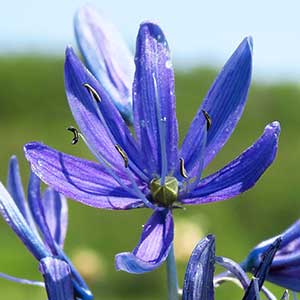Camassia quamash
Camassia quamash subsp. azurea
camas, common camas, small camas
blue camas, prairie camas
seldom clustered, globose, 1–5 cm diam.
usually fewer than 10, 1–6 dm × 4–20 mm.
4–13 mm wide, not glaucous.
20–80 cm;
sterile bracts absent, bracts subtending flowers usually equaling or exceeding pedicel.
usually zygomorphic, sometimes actinomorphic;
tepals withering separately or connivent over capsules after anthesis, long-persistent on fruiting racemes, blue or bluish violet, each 3–9-veined, 12–35 × 1.5–8 mm;
anthers usually yellow, sometimes bluish violet, violet, or brown, 2.5–7 mm; fruiting pedicel mostly incurving-erect, occasionally spreading-erect, 5–70 mm.
slightly zygomorphic or actinomorphic;
tepals withering separately after anthesis, light bluish violet, each 5–9- veined, 3-veined in outer whorls, 12–27 × 1.5–3 mm;
anthers yellow, 2.5–4 mm; fruiting pedicel spreading-erect, with capsules held away from raceme axes, 25–60 mm.
not deciduous, pale green to pale brown, ovoid, 6–19 mm.
7–15 mm.
5–10 per locule.
5–10 per locule.
= 30.
Camassia quamash
Camassia quamash subsp. azurea
camassia quamash is highly variable morphologically. although there tend to be distinct geographical variants. here recognized as subspecies following f. w. gould (1942), there is much overlap among them. the subspecific status of these taxa is retained to highlight the extreme morphological variability and geographical patterns within the species. a detailed biosystematic study of this complex is needed
Subspecies 8 (8 in the flora).
(Discussion copyrighted by Flora of North America; reprinted with permission.)
1. Tepals connivent over capsules after anthesis, usually forced apart again by capsule growth. | → 2 |
1. Tepals withering separately after anthesis, with no tendency to be connivent over capsules. | → 4 |
2. Leaves 6–15 mm wide, not glaucous; tepals 5-, 7-, or 9-veined, or occasionally 3-veined in outer whorls; n California coast ranges. | subsp. linearis |
2. Leaves 10–20 mm wide, glaucous adaxially; tepals usually 3-veined, or 5-veined, in inner whorls; w and nw United States. | → 3 |
3. Tepals bright blue to deep bluish violet, 15–20 mm; anthers bright yellow; ec California, n to Washington. | subsp. breviflora |
3. Tepals pale to deep bluish violet, 16–31 mm; anthers dull yellow to violet; s Idaho, n Utah. | subsp. utahensis |
4. Fruiting pedicels with capsules held away from raceme axes. | → 5 |
4. Fruiting pedicels with capsules usually closely appressed to raceme axes (except subsp. maxima). | → 6 |
5. Tepals light bluish violet; (bulbs 20–35 × 15–25 mm, shallowly buried in) light, well-drained prairie soils; sw Washington. | subsp. azurea |
5. Tepals bright to deep bluish violet; (bulbs 15–65 × 14–50 mm, deeply buried in) wet meadows, fields, and rocky coastal bluffs, sw British Columbia to nw Oregon. | subsp. maxima |
6. Pedicels usually 5–10 mm; flowers actinomorphic; tepals 12–20 mm; sw Oregon. | subsp. walpolei |
6. Pedicels 10–70 mm; flowers slightly zygomorphic or actinomorphic; tepals 15–35 mm; sw Canada, w Oregon and Washington e to Rocky Mountains. | → 7 |
7. Leaves not glaucous; anthers bright yellow; Oregon only. | subsp. intermedia |
7. Leaves glaucous adaxially; anthers dull yellow, bluish violet, violet, or brown; extreme sw Canada, nw United States. | → 8 |
8. Anthers never yellow, bluish violet to brown only. | subsp. quamash |
8. Anthers dull yellow, violet, or brown. | subsp. maxima |


